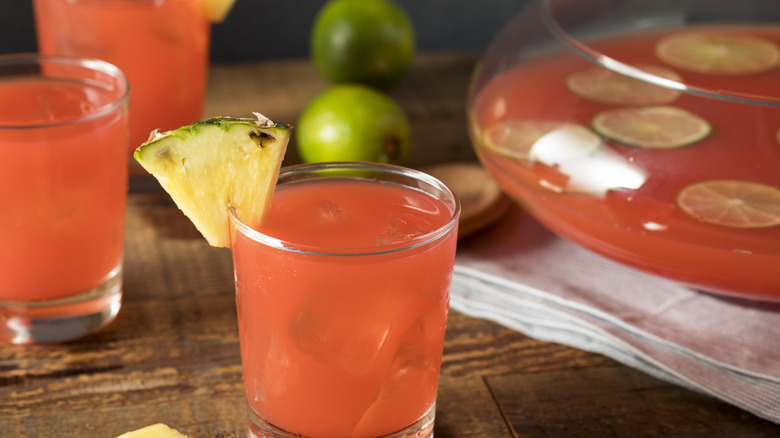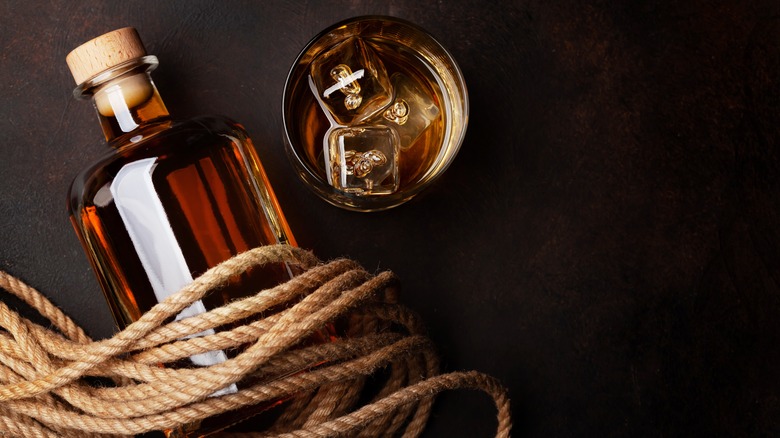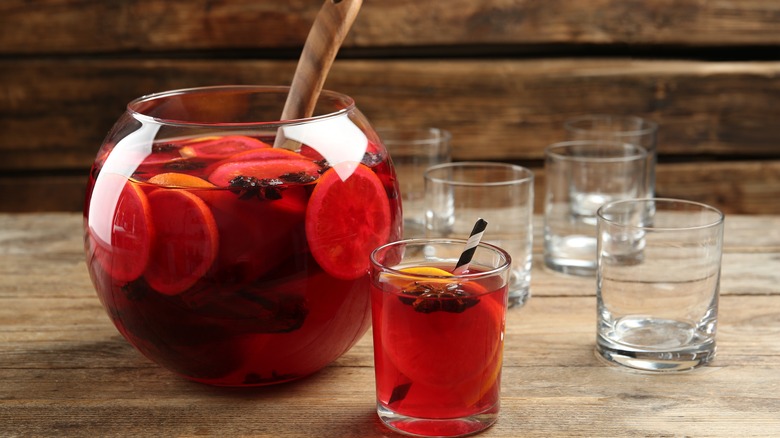The 17th Century Rum Punch Recipe That's Remembered By Rhyme
Remember the rumors about Uncle Bob spiking the wedding punch, usually whispered with a twinkle and a smile? Huge decorative bowls filled with sweet punch are not quite as common anymore, but the flowing bowls do enjoy a renaissance every few years, or decades, or centuries. That's how long punch has graced gatherings, celebrations, and simple meetups with family and friends. But original punch recipes always included the spirits (no spiking necessary.)
In fact, that was quite the point: Punch was actually invented for swarthy sailors and merchants of the British East Indies Company in the 1600s who pined for their beloved wine or beer libations (as per Difford's Guide).
Punch incarnations harken to those traditional roots, always using spirits, but rarely the earliest one, which is a black arrack liquor made from palm tree sap (via NPR). Instead, many punch-meisters now use rum, a throwback to the British colonization of "sugar countries" such as Jamaica.
Caribbean rum, also known as tipple, became the crux of punch recipes, which also included citrus juice and sugar, diluted with water, and sometimes accented by spices, as noted by David Wondrich in his book "Punch: The Delights (and Dangers) of the Flowing Bowl."
The classic mixture created the perfect balancing act for British palettes and started a punch-happy 1600s craze that waxed and waned over the centuries. Those basic punch components still stand strong, and there's even a catchy rhyme to help you remember the ratios of sweet to sour, spirits, and dilution.
A rhyming rum punch recipe
If you can count to four, you'll have no trouble remembering how to make traditional Caribbean rum punch, especially with this rhyming recipe. It's customizable according to your preferences, but the essentials are the same as they have been for generations. Just choose your ingredients based on this simple rhyme shared by Rum Therapy: "One of sour, two of sweet, three of strong, four of weak."
The quantity of each ingredient increases as the sequence progresses. Sour stands for the citrus, which is typically lime or lemon juice, followed by two of the sweet, originally in the form of pure sugar. These days, it's more common to add the sugar in an already diluted form, such as simple syrup, but you can also experiment with grenadine or other flavored syrups.
Next in the rhyme is "three of strong," which refers to the rum. It can be any rum type that strikes your fancy, from dark to light, golden, spiced, or even a flavored rum such as Malibu pineapple or watermelon.
Finally, the "four of weak" refers to diluting the mixture with water. Some punch lovers opt instead for fruit juice, depending on whether you like the extra tropical flavor it provides. A reader on Rum Therapy suggested using guava, mango, pineapple, cherry, or passion fruit, depending on availability. The reader also revealed that she uses her rum punch creations to make popsicles called Boozy Pops, selling them at a beach bar on St. Croix.
A punch from classic literature
By the 1800s, punch has declined in popularity, but that didn't stop Britain's famous pen-pusher, Charles Dickens, from incorporating it into one of his most beloved novels, "David Copperfield" (via NPR). The character of Mr. Micawber bubbled up a hot bowl of punch using essentially the same ingredients as their ancestors 200 years prior: Lemon, sugar, and spirits.
Dickens' reference to punch was far from a fleeting literary detail. The author was himself a devoted punch aficionado, not only serving it constantly to guests in his home but actually creating the fiery drink himself, literally using fire. Dickens' elaborate rum punch recipe mirrors the components of today's recipe rhyme (citrus, sugar, rum, and water), but with the addition of some brandy, flames of fire, a hot oven, and quite a few hours of his time.
According to Punch, Dickens sent a letter revealing the recipe to a friend, expressing the hope that it would make her a wonderful punch maker. And Difford's Guide relates another story of Charles Dickens writing an article about punch for "Household World" magazine titled "A Bowl of Punch." In the piece, he reportedly mourned the once-glorious punch bowls of former days being tucked away and unused.


